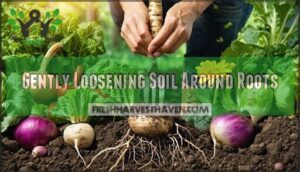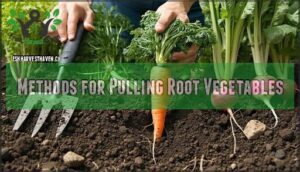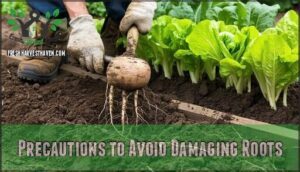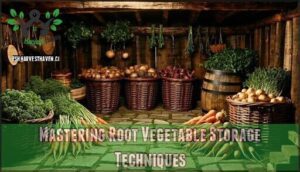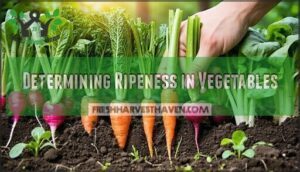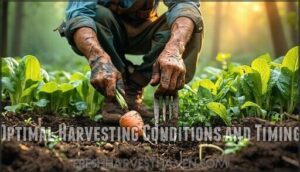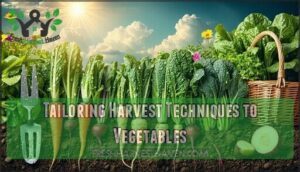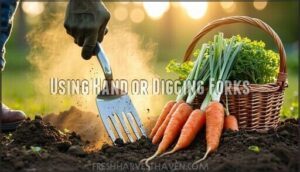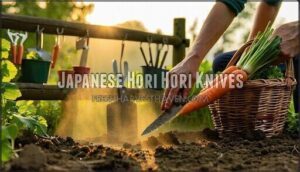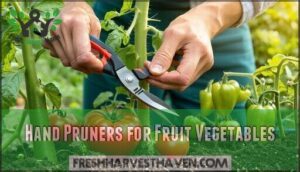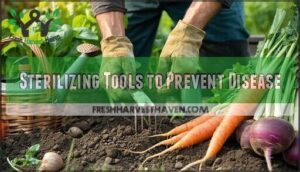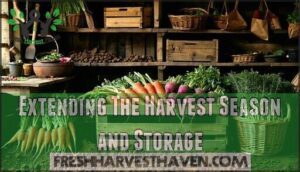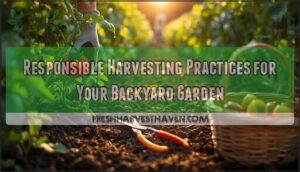This site is supported by our readers. We may earn a commission, at no cost to you, if you purchase through links.
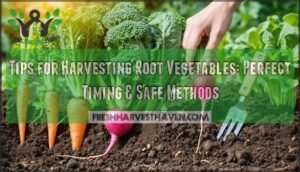
Wait until carrots show bright orange shoulders poking through soil, beets reach 2-3 inches across, and radishes feel firm when gently squeezed.
Before pulling, loosen soil around each root with a garden fork to prevent breaking. Grab the greens close to the base and pull straight up—no twisting motions that can snap roots.
Choose dry days when possible, as soggy soil makes extraction messy and difficult. Clean harvested roots gently with a soft brush, removing excess dirt without scrubbing away the protective skin.
The timing secrets and storage tricks that follow can extend your harvest season substantially, helping you to get the best results and make the most of your harvest season.
Table Of Contents
- Key Takeaways
- Choosing The Right Time to Harvest
- Harvesting Root Vegetables Safely
- Mastering Root Vegetable Storage Techniques
- Determining Ripeness in Vegetables
- Optimal Harvesting Conditions and Timing
- Tailoring Harvest Techniques to Vegetables
- Essential Tools for Harvesting Vegetables
- Extending The Harvest Season and Storage
- Frequently Asked Questions (FAQs)
- How do you harvest a root vegetable?
- Do you need tools to harvest vegetables?
- How should vegetables be handled?
- What crops need to be harvested when ripe?
- How do you know if a vegetable is ready for harvest?
- When is the best time to harvest vegetables?
- How to tell when root vegetables are ready to harvest?
- How to properly harvest vegetables?
- Does it matter what time of day you harvest vegetables?
- How to harvest correctly?
- Conclusion
Key Takeaways
- Time your harvest correctly – Wait until carrots show bright orange shoulders, beets reach 2-3 inches across, and radishes feel firm when squeezed, as proper timing determines flavor and texture quality.
- Use gentle extraction techniques – Loosen soil around roots with a garden fork first, then grip greens at the base and pull straight up without twisting to prevent breaking.
- Harvest during dry conditions – Choose dry mornings when soil isn’t waterlogged, as this makes extraction cleaner and prevents root damage while reducing disease risk.
- Store properly for extended freshness – Layer carrots in moist sand, cure onions in warm dry conditions, and maintain cool humid storage at 32-40°F with 90-95% humidity for months of preservation.
Choosing The Right Time to Harvest
Timing your root vegetable harvest correctly guarantees you’ll get the best flavor and texture from your garden.
You’ll need to know the specific maturity indicators for each crop since harvest windows vary dramatically from radishes ready in just 20-30 days to parsnips requiring 120-180 days, which is crucial for a successful harvest.
Carrot Harvest Times and Sizes
Timing determines carrot harvest success—mature roots develop when tops reach ¾ inch thick after 70-80 days.
Perfect timing transforms your garden’s potential into peak-flavor harvests worth savoring.
Here’s your harvest timing roadmap:
- Check carrot maturity by measuring shoulder width at soil line
- Test root size with gentle soil loosening around one sample carrot
- Schedule harvest timing during dry morning conditions for easier extraction
- Plan soil preparation early to guarantee proper root development
- Use carrot harvest tips like gradual pulling to maximize carrot yield
Understanding key carrot harvest times is vital for a successful harvest, and following these steps will help ensure proper root development.
Beet Harvest Times and Sizes
Beyond the thirty-day mark, your beet harvest timing becomes vital for maximum beet yield. Beet maturity occurs when shoulders peek through soil and root size reaches golf ball dimensions—typically six to eight weeks after soil preparation and planting.
Perfect beetroot harvesting requires attention to these indicators:
- Golf ball sizing: Harvest beets at this size for peak sweetness and tender texture
- Shoulder visibility: Roots pushing through soil surface signal readiness for root vegetable harvest
- Greens condition: Fresh beet greens indicate healthy root development below
Understanding soil quality factors is essential for a successful harvest. Monitor closely—harvesting beets at proper maturity guarantees maximum flavor and storage potential.
Turnip Harvest Times and Sizes
Turnip maturity peaks at tennis ball size—roughly 2-3 inches across. You’ll get the smoothest texture and best flavor at this stage.
Harvesting turnips too early yields small but tender roots, while waiting too long creates woody, bitter vegetables.
Harvest timing matters because turnips continue growing rapidly once they reach golf ball size.
Well-prepared soil conditions help achieve ideal root size within 55-60 days from planting.
Radish Harvest Times and Sizes
Harvest radishes when they reach one inch wide, typically after 20-30 days of growth. Radish maturation happens quickly, so check your crop frequently to avoid disappointing results. Root thickness serves as your primary indicator—you’ll see shoulders peeking through the soil when they’re ready. Harvest timing matters because delayed picking transforms crisp, mild radishes into woody, bitter disappointments that’ll make you question your gardening skills.
Follow these steps for the best radish harvest time:
- Check size daily once radishes approach maturity
- Look for shoulders emerging from soil moisture-rich beds
- Pull when roots measure one inch across for best flavor
- Harvest different radish varieties according to their specific timelines
- Remove from ground before they become overgrown and bitter
Harvesting radishes at peak ripeness guarantees you’ll enjoy their crisp texture and peppery bite rather than tough, unpalatable roots.
Parsnip Harvest Times and Sizes
While many gardeners rush their harvest, parsnips demand patience and proper harvest timing for maximum flavor development.
These hardy root vegetables require 120-180 days to reach parsnip maturity, making them one of the longest-growing crops in your garden.
Frost impact actually enhances their sweetness by converting starches to sugars, so don’t panic when temperatures drop.
You’ll know they’re ready when the root depth reaches 1-2 inches thick at the crown and shoulders peek above soil level.
Soil preparation matters here—loose, well-drained earth makes harvesting parsnips much easier.
Use a garden fork to gently loosen soil around each root before pulling.
This careful approach prevents breaking during extraction and guarantees you get the full length of these valuable root vegetable harvest gems.
Harvesting Root Vegetables Safely
Proper harvesting techniques protect your root vegetables from damage and guarantee maximum quality.
You’ll need to use gentle methods and the right tools to extract these underground treasures without breaking or bruising them.
Gently Loosening Soil Around Roots
Start by selecting your most trusted tool – a hand fork works best for soil loosening around delicate roots.
Position the fork several inches away from the root’s estimated location, then work inward with gentle movements. This prevents accidental slicing through your precious harvest.
Control your digging depth carefully, stopping when you feel the fork encounter resistance.
- Pro tip: Moist soil compacts easily, so wait for drier conditions when possible for easier gentle extraction.
Methods for Pulling Root Vegetables
Everyone benefits from proper root extraction techniques when harvesting root vegetables.
Grip the greens firmly at their base and pull steadily upward without twisting motions.
Gentle pulling prevents breakage while maintaining root integrity.
For tougher crops like carrots, tool selection matters—use digging forks for effective soil loosening before extraction.
Fork techniques involve inserting the tool several inches away from roots, then lifting gently.
Short-rooted vegetables like radishes require only foliage pulling, while long-rooted crops need preliminary root damage prevention through careful loosening.
Precautions to Avoid Damaging Roots
Root damage happens faster than you think when harvesting. Proper damage prevention starts with understanding that compacted soil acts like concrete around your precious vegetables. Choose your tools wisely—garden forks outperform shovels for gentle extraction because they don’t slice through roots like knives through butter. Harvest timing matters too; wait for dry conditions when soil crumbles easily rather than clumps together.
Your harvesting techniques determine root health outcomes:
- Use steady pressure instead of jerky movements that snap delicate roots
- Work around the plant rather than pulling straight up from muddy ground
- Select proper tools like digging forks that minimize soil compaction
- Practice gentle handling by supporting the entire root during extraction
Tool selection makes the difference between perfect roots and broken disappointments.
Mastering Root Vegetable Storage Techniques
Once you’ve harvested your root vegetables, proper storage techniques determine whether they’ll last weeks or months.
The right storage conditions can extend your harvest well into winter, giving you fresh vegetables when grocery store prices soar, which is a significant advantage of using proper storage techniques.
Cool, Humid Storage for Beets
After harvesting your beets safely, proper beet storage becomes your next priority.
Store beets at cool temperatures between 32-40°F with humid conditions at 90-95% relative humidity for ideal beet preservation.
Use perforated plastic bags or root cellars to maintain these conditions.
Trim greens to one inch above the root, but don’t wash the beets before storing.
Cool storage and humid storage keep your root vegetable harvest fresh for up to six months when conditions remain consistent.
For more information on managing the quality of your beets, consider reviewing beet harvest tips to optimize your yield.
Layering Carrots in Moist Sand
Sand layering provides superior carrot storage compared to refrigeration alone. Clean, slightly damp sand creates ideal moisture control for root preservation.
Follow these steps for effective sand storage:
- Select fine, clean sand with proper sand quality
- Trim carrot tops to prevent moisture loss
- Layer carrots without touching in containers
- Maintain consistent moisture levels throughout storage
- Check periodically and remove any deteriorating roots
This root vegetable storage method extends freshness for months when conditions stay cool and humid.
Curing Onions for Long-Term Storage
While carrots benefit from sand storage, onion bulbs require a different approach.
Proper onion curing prevents storage rots and extends shelf life substantially. Start by harvesting when tops fall over naturally, then cure in warm, dry conditions at 80°F for 2-4 weeks. This dry curing process toughens outer skins and seals neck areas.
After curing, implement these longterm storage techniques:
- Trim dried tops to one inch above bulbs
- Use mesh bags for proper ventilation
- Maintain cool, dry conditions below 40°F
- Inspect regularly for soft spots or sprouting
- Separate damaged bulbs to prevent rot spread
Well-cured onions stored using proper root vegetable storage methods can last 6-8 months. These onion preservation and curing techniques guarantee your harvest remains fresh through winter months.
Determining Ripeness in Vegetables
Knowing when your root vegetables are perfectly ripe saves you from harvesting woody carrots or bitter radishes too early or too late.
You’ll use visual signs like carrot shoulder width, tactile tests for firmness, and size measurements to determine the ideal harvest moment for each crop.
This approach ensures that you can identify the ideal harvest moment and enjoy your root vegetables at their best.
Visual Cues for Vegetable Ripeness
Mastery comes from recognizing the subtle signals your vegetables send when they’re ready. Color Changes reveal peak ripeness—carrots display rich orange shoulders, beets show deep red or purple hues, and turnips exhibit vibrant white or purple coloring.
Skin Texture provides essential maturity indicators; smooth, firm surfaces without soft spots signal perfect timing. Root Shape matters tremendously—straight, even forms indicate healthy development, while cracks suggest you’ve waited too long.
Stem Thickness offers additional visual cues; carrot tops reaching ¾-inch diameter typically mean readiness. Leaf Wilting or yellowing warns that vegetable ripeness has peaked.
These ripeness signs form your complete root vegetable harvesting guide.
Cues What to Check What It Tells You
Tactile Cues for Vegetable Ripeness
When testing tactile cues for vegetable ripeness, feel for firm root texture and slight soil resistance when gently tugging.
Fresh roots display minimal vegetable flex and tight skin without skin slip.
Check stem dryness at the crown—dried, papery tops often signal readiness.
These tactile cues guide proper root vegetable harvest timing using proven harvesting techniques in root vegetable gardening.
Checking Vegetable Size and Ease of Picking
You’ll know your root vegetables are ready when size and picking ease align perfectly with crop maturity indicators. Root size matters—carrots should reach three-quarters inch thickness, while beets hit golf ball dimensions. Test picking ease by gently loosening soil; mature roots lift smoothly without resistance. Vegetable readiness shows through firm texture and proper proportions for each variety.
- Confidence boost: Successfully timing your harvest creates deep gardening satisfaction
- Peace of mind: Proper vegetable harvesting techniques prevent crop loss and waste
- Pride moment: Perfect root vegetable harvest showcases your growing expertise
- Relief feeling: Gentle handling protects months of careful cultivation work
Optimal Harvesting Conditions and Timing
Weather conditions substantially impact your root vegetable harvest success and the quality of your crops.
You’ll achieve the best results by timing your harvest for early morning hours during dry weather periods.
Harvesting in Early Morning
Why harvest when morning dew still clings to your garden? Early morning offers the perfect window for harvesting root vegetables when they’re at peak crispness and flavor. Cool temperatures and natural moisture create optimal soil conditions, making extraction easier while preserving your crop’s quality.
The dew management benefits are clear—vegetables retain maximum water content before afternoon heat causes wilting. Morning harvest tips include these key practices for successful root vegetable harvesting techniques:
- Garden soil remains firm yet workable after overnight moisture settles
- Vegetable harvest tips show roots pull cleanly from cool, stable ground
- Early picking prevents pest interference and reduces crop stress
- Root vegetable harvest yields maximum flavor before heat builds
- Crisp harvesting conditions preserve texture and extend storage life
Understanding the essential harvest time is crucial for maximizing crop quality. Start your harvest vegetable garden routine between dawn and mid-morning for consistently superior results.
Avoiding Harvest After Rain
When rain saturates your garden, resist harvesting root vegetables immediately.
Waterlogged soil increases root damage during gentle extraction and causes soil compaction that harms future crops.
Wait 24-48 hours for ideal moisture levels—dry conditions make harvesting cleaner and safer.
Proper harvest timing prevents bruising, splitting, and disease while ensuring your root vegetable harvest maintains quality and storage potential.
Benefits of Dry Weather Harvesting
Smart gardeners harness dry weather’s power for superior root vegetable harvests. Dry Soil Benefits create ideal conditions that prevent Soil Compaction and enable gentle extraction without root damage.
Here’s why timing matters for dry weather harvesting:
- Root Protection – Firm soil structure prevents breakage during extraction
- Harvest Ease – Less mud means cleaner, faster collection
- Crop Longevity – Reduced moisture prevents rot and extends storage life
- Disease prevention – Dry conditions minimize fungal contamination risks
Tailoring Harvest Techniques to Vegetables
Each root vegetable requires its own specific harvesting technique to prevent damage and maximize quality.
You’ll need to adjust your approach based on the crop’s root structure, soil depth requirements, and natural harvesting cues.
Harvesting Root Vegetables Gently
Proper technique transforms root extraction from a wrestling match into smooth harvesting. When soil loosening reveals shoulders, you’re ready for gentle pulling that prevents costly root damage.
Master these fork techniques for successful harvests:
- Position your garden fork 4-6 inches from the root base to avoid piercing
- Angle the fork slightly toward the root while pushing down to break soil compaction
- Lift and rock gently to create space before attempting any pulling motion
Once you’ve completed soil loosening, grip the greens firmly at their base—never the delicate leaves. Apply steady upward pressure without twisting motions that snap roots. Your harvest timing pays off when roots slide free intact, rewarding your patience with perfect vegetables ready for storage.
Extracting Root Vegetables From Soil
Once you’ve loosened the soil around your root vegetables, it’s time for the actual root extraction process.
Use proper fork techniques to gently lift and separate roots from compacted earth. Insert your harvest tools at an angle, working around the vegetable’s perimeter to avoid root damage.
In ideal soil conditions, carrots and parsnips should slide out smoothly. The key to successful root vegetable harvesting is patience—rushing this root vegetable harvesting process leads to broken vegetables and wasted effort, highlighting the importance of proper fork techniques and gentle handling.
Harvesting Fruiting Vegetables
Fruit ripening indicators include full color development and gentle firmness when pressed.
Use sharp pruners for clean cuts on tough stems like eggplant and squash, while gentle twisting works for tender crops.
- Cut thick-stemmed fruits with pruners to prevent plant damage
- Harvest regularly during peak season to maintain vegetable yields
- Cool immediately after harvesting techniques to preserve freshness
Harvesting Leafy Greens and Brassicas
Sharp, clean cuts prevent damage when harvesting leafy greens and brassicas.
Snip outer leaves of leafy greens when they’re vibrant and mature, leaving inner growth for continuous yield.
Cut brassica heads at the base with precise strokes.
Handle gently to avoid bruising delicate leaves.
These harvesting techniques guarantee better postharvest handling and extended storage life for your leafy crops.
Essential Tools for Harvesting Vegetables
You’ll need the right tools to harvest root vegetables without damaging them or breaking your back in the process.
A garden fork, Hori Hori knife, and clean pruners make the difference between a successful harvest and a pile of broken carrots.
Using Hand or Digging Forks
Garden forks transform root vegetable harvesting from a wrestling match with stubborn soil into smooth extraction.
Choose your weapon wisely—lightweight forks work best in sandy soil, while heavy-duty versions tackle clay without bending.
Position your digging fork at a slight angle about four inches from the root’s base, considering the vegetable’s expected depth.
Insert gently using Fork Techniques that prioritize Soil Loosening over brute force.
Rock the handle back and forth to create space around the root before lifting.
This Gentle Harvesting approach prevents snapping carrots or damaging delicate parsnips.
- Master hand forks for smaller root vegetables where precision trumps power during Root Extraction
Let the tool handle the work—forcing through compacted earth damages both your fork and the vegetables you’re trying to harvest.
Understanding proper garden fork types is essential for effective root vegetable harvesting.
Japanese Hori Hori Knives
When precision matters most in root vegetable harvesting, the Japanese Hori Hori knife stands unmatched among garden tools. This versatile blade combines a sharp edge with serrated teeth, making it ideal for soil loosening around delicate carrots and beets without causing damage.
The knife’s pointed, concave blade excels at root extraction by cutting through compacted earth and stubborn root systems. Its full-tang construction guarantees durability during demanding harvesting tasks, while measurement markings help gauge planting depths.
For maximum Hori Hori uses, maintain the blade through regular knife sharpening with whetstones. Quality models from brands like Nisaku feature rust-resistant stainless steel that withstands repeated soil contact.
Here’s what sets it apart:
This multi-functional tool prevents common root vegetable harvesting mistakes by providing precise control during extraction. Gardeners can benefit from understanding the proper Hori Hori Knife selection to enhance their harvesting experience.
Hand Pruners for Fruit Vegetables
Hand pruners excel beyond root vegetables for harvesting tomatoes, peppers, and other fruiting plants. These Gardening Tools deliver precise cuts that protect plant health during Crop Maintenance activities.
Follow these Pruning Techniques for ideal Fruit Handling:
- Select bypass pruners with sharp blades for clean cuts through stems
- Position blades close to the main stem when harvesting fruits
- Apply gentle pressure to avoid crushing delicate vegetables during removal
- Clean blades between plants to prevent disease transmission
- Store pruners properly to maintain cutting edge sharpness
- Practice proper Vegetable Grooming by removing damaged or overripe produce regularly
Quality hand pruners make harvesting efficient while ensuring your plants stay healthy for continued production throughout the growing season. Effective gardening also involves using the right best harvesting tools to minimize damage and maximize yield, which is a key part of proper gardening and efficient harvesting.
Sterilizing Tools to Prevent Disease
Clean equipment protects your harvest from disease spread.
Sterilize tools between plants using 70% isopropyl alcohol wipes for quick sanitization.
For deeper cleaning, apply 10% bleach solutions weekly or 3% hydrogen peroxide after rainy conditions.
Monthly boiling water rinses remove stubborn contaminants.
These sterilization methods and hygiene practices guarantee disease prevention throughout your root vegetable harvesting season.
Regular use of alcohol wipe solutions is vital for effective tool sterilization and ensures a healthy harvest with proper hygiene practices.
Extending The Harvest Season and Storage
You can extend your harvest season through strategic planting and proper storage techniques that keep fresh vegetables on your table for months.
Smart succession planting combined with effective curing methods transforms a single growing season into year-round homegrown nutrition.
Succession Planting for Continuous Harvest
Staggered plantings create an assembly line of fresh root vegetables throughout your growing season.
Plant succession crops every two to three weeks to guarantee continuous harvesting when one bed finishes producing.
- Crop Rotation: Alternate root vegetables with different families to prevent disease buildup
- Seed Spacing: Reserve garden sections for successive plantings rather than filling entire beds
- Plant Scheduling: Start new sowings when previous crops reach half maturity
- Growth Stages: Match varieties with different harvest intervals for extended yields
- Harvest Intervals: Time plantings so crops mature every 10-14 days for steady supply
Regular Harvesting to Prolong Season
While succession planting sets up your garden’s timeline, regular harvesting keeps your root vegetables performing at peak levels throughout the season.
Frequent picking prevents crops from becoming woody and encourages continued production in varieties that support multiple harvests.
Here’s how consistent harvesting root vegetables maximizes your continuous yield:
- Harvest scheduling every 7-10 days maintains superior quality and prevents overgrowth
- Root preservation improves when you pick at proper maturity rather than waiting too long
- Season extension happens naturally as plants redirect energy into new growth
Smart continuous cropping means checking your beds regularly and pulling ready vegetables promptly.
Cut and Come Again Crops
Several leafy greens offer cut-and-come-again harvesting, maximizing your continuous yield without replanting.
Use stem cutting techniques on spinach, lettuce, kale, and arugula for extended harvest periods.
These leafy greens provide regrowth tips that’ll keep your salad bowl full.
Curing and Storing Vegetables for Long-Term
After harvest, your vegetables need proper curing process and storage.
Start by curing onions at 80°F in dry, ventilated areas until skins turn papery.
For root vegetable storage, layer carrots in slightly moist sand within containers.
Root cellars or cool basements provide optimal storage conditions – maintain 32-40°F with 90-95% humidity.
These humid environments prevent shriveling while cold temperatures slow decay.
Proper vegetable curing and cool storage techniques guarantee your crop preservation lasts months, keeping your harvest fresh through winter.
Frequently Asked Questions (FAQs)
How do you harvest a root vegetable?
Loosen soil gently around roots using a garden fork, then pull steadily by gripping greens at the base. Don’t twist—you’ll snap them. Harvest during dry conditions for easier extraction.
Do you need tools to harvest vegetables?
Yes, you’ll need basic tools for efficient harvesting.
A garden fork loosens soil around roots without damage, while a hand trowel works for smaller vegetables.
You can pull radishes by hand, but carrots need gentle digging first.
How should vegetables be handled?
Handle root vegetables like precious cargo—grip greens firmly at the base, pull steadily without twisting, and brush off loose dirt gently.
Keep them cool and avoid washing until you’re ready to use them.
What crops need to be harvested when ripe?
Time-sensitive crops like radishes become bitter if left too long, while turnips get woody past tennis-ball size. You’ll want to harvest most roots at their peak sweetness and texture.
How do you know if a vegetable is ready for harvest?
Check visual cues like size and color changes. Root vegetables show readiness when they reach appropriate diameter, tops begin drying, or shoulders peek through soil surface.
When is the best time to harvest vegetables?
Early bird catches the worm – harvest vegetables when they’ve reached peak maturity but haven’t become tough or fibrous. You’ll get the best flavor and texture when timing’s just right.
How to tell when root vegetables are ready to harvest?
Look for visual cues like carrot shoulders peeking through soil or beet tops reaching three-quarters inch thickness. Most roots signal readiness when they’ve reached their expected size and maturity timeline.
How to properly harvest vegetables?
A perfectly timed harvest can make or break your entire season’s work! Use a garden fork to gently loosen soil around roots, then pull steadily without twisting to avoid damage.
Does it matter what time of day you harvest vegetables?
Yes, timing matters substantially.
Harvest root vegetables during cool, dry mornings after dew evaporates but before direct sunlight hits.
This timing maximizes crispness and water content while making handling easier and reducing damage risk.
How to harvest correctly?
Sure, you’ve mastered the art of procrastination—now master harvesting.
Use a garden fork to loosen soil around roots, then pull steadily by the greens without twisting.
Harvest during dry conditions for easiest extraction.
Conclusion
Like a well-timed symphony, successful root vegetable harvesting combines proper timing with careful technique.
You’ve learned essential tips for harvesting root vegetables, from recognizing visual cues to using appropriate tools.
Remember to harvest during dry conditions, loosen soil gently with a fork, and pull straight up without twisting.
Store your crops properly using sand layering for carrots and cool, humid conditions for beets.
These proven methods guarantee maximum yield quality and extended storage life for your homegrown vegetables.
- https://yardandgarden.extension.iastate.edu/how-to/vegetable-harvest-guide
- https://blog.southernexposure.com/2021/08/fall-harvest-storing-preserving-root-crops/
- https://piedmontmastergardeners.org/article/guidelines-for-harvesting-vegetables/
- https://japan-agritrading.com/products/root-vegetables-harvesting-tools
- https://www.youtube.com/watch?v=sUgmCQ2aQZs

